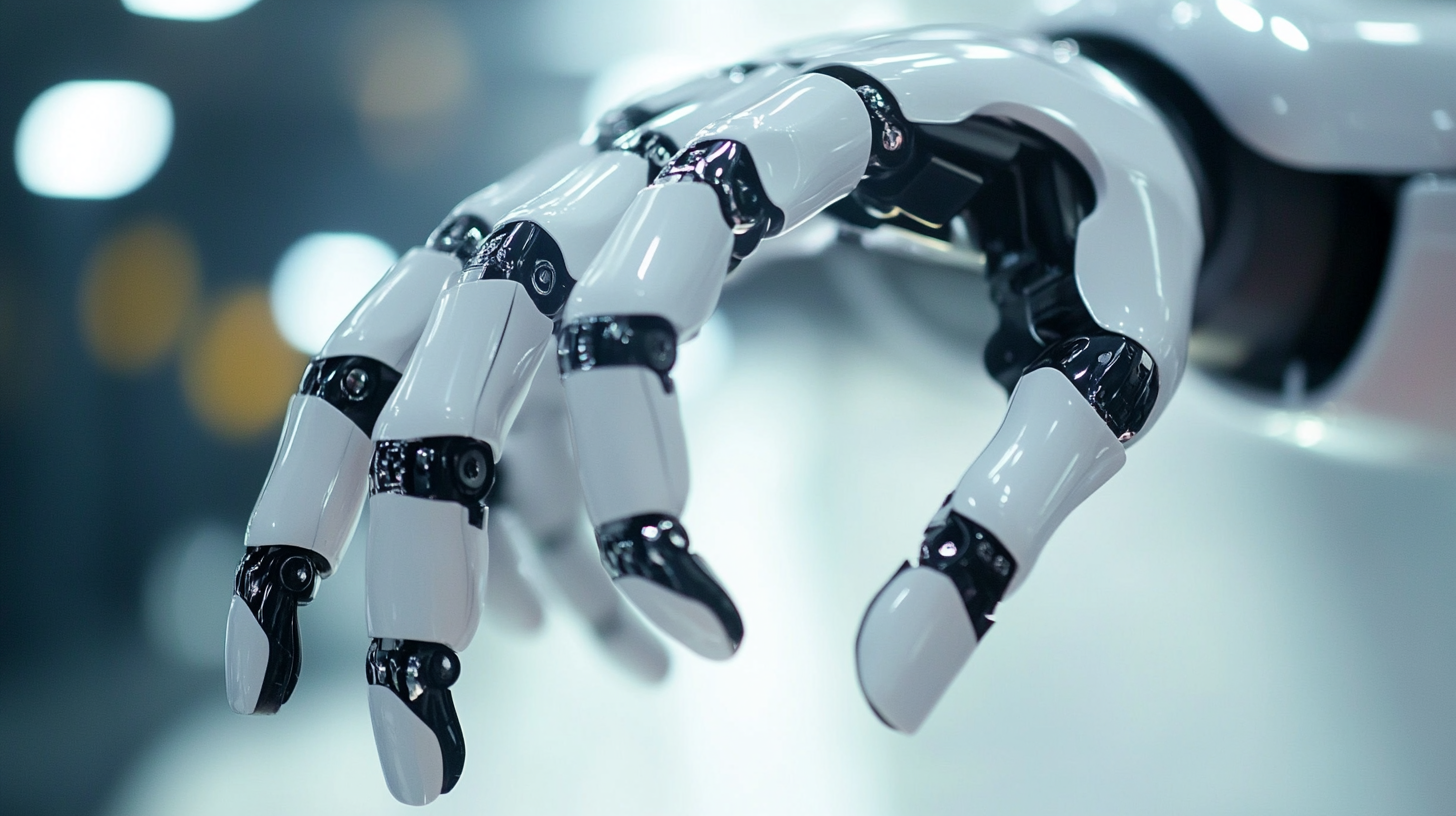

14, Raghava Enclave, Transport Road, Secunderabad, Hyderabad (500009)
©2024 All Rights Reserved by excitechrobot.com
In recent years, the landscape of technology has been dramatically transformed by the rise of Mobile Robots. These autonomous machines are no longer confined to science fiction; they have become integral to various industries, enhancing efficiency, productivity, and safety. As we look toward 2025, it is clear that Mobile Robots will play a pivotal role in shaping the future of work and everyday life. From logistics and warehousing to healthcare and agriculture, the capabilities of these robots are expanding, creating new opportunities and challenges for businesses and society alike.
As we navigate the complexities of this evolving field, it is crucial to identify the key trends that will influence the Mobile Robots industry in the coming years. Factors such as advancements in AI and machine learning, the push for sustainability, and the ongoing quest for seamless human-robot collaboration are all set to redefine how these robots operate and coexist with humans. This blog will delve into five critical trends that are not only driving innovation but also shaping the trajectory of Mobile Robots through 2025 and beyond.

The rise of autonomous navigation technologies is fundamentally transforming the landscape of mobile robotics, a trend that is projected to escalate through 2025. As industries from manufacturing to logistics integrate these technologies, mobile robots capable of navigating complex environments without human intervention are becoming increasingly prevalent. According to a recent report by MarketsandMarkets, the global autonomous mobile robots market is expected to grow from USD 4.2 billion in 2020 to USD 21 billion by 2025, reflecting a compound annual growth rate (CAGR) of 37.4%. ABB’s recent launch of its new autonomous mobile robot (AMR) product line underscores the urgency for enterprises to adopt these innovative solutions. By enhancing operational efficiency and reducing labor costs, these robots can autonomously navigate through warehouse aisles and factory floors, optimizing material handling processes. This aligns with the findings of a study by McKinsey, which indicates that companies employing AMRs can enhance productivity by up to 40% while enabling their workforce to focus on higher-value tasks. Moreover, advancements in sensors, artificial intelligence (AI), and machine learning are propelling autonomous navigation technologies to new heights. As highlighted in the International Federation of Robotics (IFR) report, the integration of advanced perception systems allows mobile robots to better understand their surroundings, leading to safer and more reliable operations. The convergence of these technologies is not just creating smarter robots but also enabling them to work collaboratively alongside human operators in dynamic environments, further illustrating the paradigm shift underway in the mobile robotics industry as we move closer to 2025.

As the landscape of mobile robotics evolves, the integration of artificial intelligence (AI) and machine learning is poised to significantly enhance robotic performance, setting a new standard for efficiency and effectiveness in various industries. According to a recent report by Fortune Business Insights, the global AI in robotics market is projected to reach $22.4 billion by 2028, growing at a CAGR of 34.5% from 2021 to 2028. This rapid growth underscores the importance of AI algorithms in processing vast amounts of data generated by robotic sensors, enabling machines to learn from their environments and improve their decision-making capabilities over time.
Machine learning techniques, in particular, are revolutionizing how mobile robots operate. By utilizing deep learning, robots can analyze images, recognize objects, and adapt their behavior in real-time. This ability to self-learn not only reduces human intervention but also increases uptime and operational reliability. According to a report from McKinsey, companies that effectively integrate AI into their operations could see productivity improvements of up to 40%, making the investment in AI-driven mobile robots increasingly attractive for businesses across sectors like logistics, healthcare, and manufacturing.
Moreover, the incorporation of AI and machine learning also enhances safety protocols for mobile robots. Systems equipped with advanced perception algorithms can detect obstacles and navigate complex environments with precision, minimizing the risk of accidents. Research from ABI Research indicates that by 2025, approximately 70% of all new mobile robots will be infused with AI capabilities, marking a definitive shift toward smarter, more autonomous machines. This trend not only aids in operational efficiency but also fosters a safer working environment, ultimately driving the future of mobile robotics.

The landscape of mobile robots is evolving rapidly, driven by advancements in technology and a growing demand for automation across various sectors. One of the most significant trends is the expansion of applications beyond traditional settings like warehousing. As businesses seek innovative solutions to streamline operations, mobile robots are increasingly being deployed in urban environments, enhancing mobility and logistics.
In warehousing, mobile robots have already transformed inventory management and order fulfillment processes. However, their capabilities are now being extended to urban mobility solutions, such as autonomous delivery services and ride-sharing. Companies are harnessing these robots to navigate complex urban landscapes, efficiently delivering goods while addressing challenges like traffic congestion and last-mile logistics. This shift not only improves operational efficiency but also provides customers with faster, more convenient service.
Additionally, community services are embracing mobile robots. From assisting the elderly in healthcare to ensuring safety in public spaces, these robots are enhancing urban living. As cities invest in smart infrastructure, the integration of robots into daily life is becoming increasingly seamless. As we approach 2025, the trend towards blending mobile robots into urban environments is set to redefine how we interact with technology, making our cities smarter and more connected than ever.

As mobile robots proliferate in various sectors, ensuring safety and compliance with regulations becomes paramount. The landscape of robotics is gradually evolving, with regulatory bodies stepping up to develop frameworks that address the unique challenges presented by these autonomous systems. From manufacturing and logistics to healthcare and surveillance, safety protocols must adapt to the diverse environments in which these robots operate.
One of the key developments in the safety and regulation arena is the standardization of operational guidelines. By 2025, we can expect clearer definitions of roles and responsibilities for manufacturers, operators, and users of mobile robots. This includes the need for robust risk assessment procedures, regular safety audits, and adherence to ethical considerations that govern robot interactions with humans and the environment. As companies strive to integrate robots into their operations seamlessly, they will also need to focus on establishing compliance strategies that align with evolving regulatory landscapes.
An additional trend is the increased collaboration between industry stakeholders and regulatory authorities to create comprehensive safety metrics that address both functional capabilities and cybersecurity risks. As robots become smarter and more connected, ensuring the safety of data transmission and the integrity of robotic systems will be critical. This collaborative approach will not only enhance safety standards but also boost public confidence in adopting mobile robotics solutions across various sectors. Moving towards 2025, staying informed and compliant will be essential for any organization looking to harness the benefits of mobile robots while meeting safety expectations.
You know what's really exciting? The world of mobile robotics is going through a major transformation towards being more sustainable, and it’s all thanks to our urgent need for eco-friendly solutions. Companies everywhere are making it a priority to cut down on their carbon footprints, which means we're starting to see mobile robots being built with green features. These innovations don’t just boost their efficiency—they actually help lessen their impact on the environment, too! Take, for example, the leaps we’ve made in battery tech and energy management. Now, robots can run for much longer while using less power, which is a huge step toward cutting energy consumption. And have you heard about solar-powered robots? They’re starting to pop up, allowing us to tap into renewable energy sources, which is just awesome for our planet’s future.
Then there’s this cool trend where manufacturers are using recycled materials to make these robots. Yeah, you heard that right! Companies are figuring out how to incorporate recycled plastics and metals into their designs. This really helps reduce waste and promotes a circular economy. It’s not just about making the robots more eco-friendly; it’s also about fostering a culture of sustainability in the robotics scene. When builders adopt these eco-conscious practices, it sets a fantastic example for others to follow.
Plus, mobile robots are popping up in all kinds of industries, helping boost sustainability in a big way. Like in agriculture, where autonomous robots make sure resources are used efficiently while cutting down on chemicals. Or in logistics, where delivery robots are supercharging transport efficiency and slashing emissions. Honestly, mobile robotics is becoming a crucial partner in driving sustainable practices forward. By getting on board with these eco-friendly innovations, the mobile robotics field isn’t just advancing tech; it’s also playing a vital part in the global push for sustainability.
